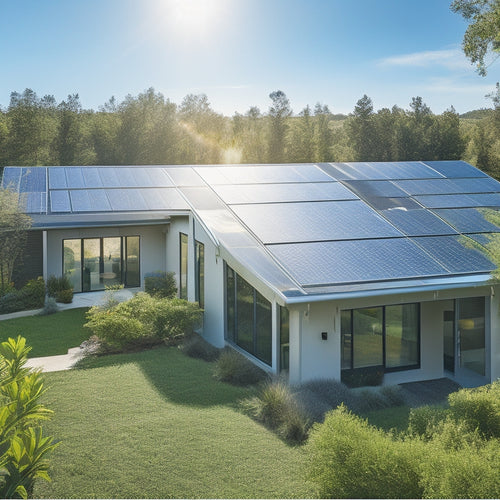
How to Install Residential Solar Energy Systems
Share
To install residential solar energy systems, start by evaluating your roof type and selecting appropriate solar panels, inverters, and batteries. Consider financial incentives like federal tax credits and local rebates to lower your initial costs. Verify your solar panels are oriented south for maximum sunlight capture, and determine the best angle based on your roof's shape. Prioritize reliable brands with good warranties for long-term performance. Once installed, monitor your system's efficiency regularly to capture the full benefits of solar energy. There's much more to investigate about optimizing your solar setup and maneuvering the installation process.
At a Glance
- Assess your home's energy needs and potential savings to determine the right solar system size and type.
- Choose suitable solar panels (monocrystalline, polycrystalline, or thin film) based on efficiency, cost, and aesthetic preferences.
- Select the appropriate inverter type (string, microinverter, or power optimizer) for optimal energy conversion and performance.
- Consider roof materials and angles to ensure proper installation and maximize solar energy production.
- Explore financing options and government incentives to reduce upfront costs and enhance affordability of your solar energy system.
Cost-Effective Energy Solution
When considering solar energy systems, you'll find significant long-term savings potential, as reduced electricity bills can add up over time.
Solar panels can reduce energy costs by 50-75%, translating to annual savings of $400-$1,000.
Additionally, various government incentives can further enhance your return on investment, making solar energy an even more attractive option for homeowners.
Long-Term Savings Potential
Considering the rising costs of traditional energy sources, investing in residential solar energy systems presents a cost-effective solution with considerable long-term savings potential. By utilizing the sun's energy, you can drastically reduce or even eliminate your monthly electricity bills. This shift not only alleviates the financial strain of fluctuating energy prices but also enhances your independence from utility companies.
When you investigate financing options, you'll find various paths to making solar energy more accessible. Loans, leases, and power purchase agreements can notably reduce your upfront costs, allowing you to start saving sooner. Over time, the savings on your energy bills can yield a substantial return on investment, often recovering the initial costs within a few years.
Moreover, as energy prices continue to climb, your fixed solar costs remain stable, maximizing your financial benefits. Investing in solar power also increases your home's value, making it a smart choice for long-term financial planning.
Government Incentives Available
Governments at various levels offer a range of incentives to make residential solar energy systems more affordable and appealing to homeowners. One of the most significant benefits is federal tax credits, allowing you to deduct a portion of your installation costs from your federal tax bill.
Many states also provide state rebates, putting more cash back in your pocket. Additionally, local incentives can vary widely, so it's important to check what's available in your area.
Financing options like solar loan programs enable you to spread out the cost of your system over time, making it manageable. Installation grants may also be available, covering a portion of your upfront expenses.
You can further benefit from renewable energy certificates, which can be sold to utility companies looking to meet renewable energy mandates.
Additionally, property tax exemptions mean your home's value won't increase due to your solar system, protecting you from higher property taxes.
Environmental Impact Reduction
Installing residential solar energy systems greatly lowers your carbon footprint by reducing dependence on fossil fuels.
By utilizing sustainable energy, you contribute to a cleaner environment and promote long-term ecological balance.
Additionally, solar power generates no emissions, aiding in climate change mitigation and enhancing your home's value through notable savings on energy bills.
This shift not only benefits you economically but also plays an essential role in combating climate change.
Lower Carbon Footprint
Shifting to solar energy not only benefits your wallet but also greatly lowers your carbon footprint. By utilizing the sun's power, you reduce your reliance on fossil fuels, which are major contributors to greenhouse gas emissions. This change is a key component of effective carbon offset strategies, allowing you to take responsibility for your energy consumption while promoting a cleaner environment.
When you install residential solar systems, you're implementing sustainable practices that align with a vision of freedom from traditional energy sources. You not only generate your own electricity but also contribute to a collective effort in combating climate change. Each kilowatt-hour produced from solar energy means fewer emissions released into the atmosphere, making your home part of a broader commitment to sustainability.
Additionally, many utilities offer incentives for solar energy users, further enhancing the financial benefits. As you decrease your carbon footprint, you're also supporting local economies and stimulating innovation in renewable technologies.
Embracing solar energy enables you to make a significant impact, encouraging a shift toward a more sustainable future for everyone. Take charge of your energy choices and enjoy the freedom that comes with reducing your environmental impact.
Sustainable Energy Source
Solar energy stands out as a sustainable energy source that greatly reduces environmental impact. By utilizing the sun's power, you tap into a renewable energy resource that minimizes reliance on fossil fuels, which are finite and polluting.
When you install a solar energy system, you considerably lower greenhouse gas emissions, contributing to cleaner air and a healthier planet.
Moreover, solar energy promotes energy independence. You're not just generating electricity; you're taking control of your energy future. By producing your own energy, you lessen your dependence on the grid and fluctuating energy prices.
This autonomy enables you, allowing you to make choices that align with your values, particularly the desire for freedom and sustainability.
Transitioning to solar also means you minimize the ecological footprint associated with traditional energy sources. The manufacturing and installation processes of solar panels are becoming increasingly efficient and environmentally friendly, further enhancing their appeal as a sustainable option.
Key Components Overview
When installing a residential solar energy system, understanding the key components is vital for peak performance.
You'll need to evaluate the types of solar panels available and how inverter functionality plays a role in converting solar energy into usable electricity.
Additionally, selecting a reliable solar battery is fundamental for effective energy storage and maximizing efficiency.
Brands with extensive warranty periods (10-15 years) should be prioritized for long-term performance top solar battery brands.
This knowledge will help you make informed decisions throughout the installation process.
Solar Panels Types
In the world of residential solar energy systems, understanding the various types of solar panels is essential for making an informed decision. Each panel type has its unique characteristics, so let's break them down.
| Panel Type | Key Features |
|---|---|
| Monocrystalline | High solar panel efficiency, sleek aesthetic options, longer performance warranties. |
| Polycrystalline | Good solar panel efficiency, slightly lower cost, more varied installation methods. |
| Thin Film Technology | Lightweight, flexible, lower efficiency, minimal maintenance requirements. |
Monocrystalline panels are known for their high efficiency and longevity, making them a popular choice for homeowners aiming for maximum energy output. Polycrystalline panels offer a cost-effective alternative with decent efficiency, making them accessible for budget-conscious consumers. Thin film technology, while less efficient, can fit unique installation needs due to its flexibility and lightweight nature.
When choosing the right solar panel, consider your installation methods, aesthetic preferences, and long-term maintenance requirements. A thorough understanding of these options allows you to select the best fit for your home, giving you the freedom to utilize solar energy effectively.
Inverter Functionality Explained
Understanding inverter functionality is vital for optimizing your residential solar energy system's performance. Inverters convert the direct current (DC) generated by your solar panels into alternating current (AC), which powers your home.
There are three main inverter types: string inverters, microinverters, and power optimizers. String inverters connect multiple panels in a series, making them cost-effective but less efficient if one panel is shaded. Microinverters, installed on each panel, maximize energy output but can be pricier. Power optimizers combine the benefits of both, enhancing performance while allowing for a more straightforward installation.
Inverter maintenance is essential to guarantee long-term efficiency. Regularly check your inverter's display for error messages, and keep its vents clean to prevent overheating.
It's also wise to schedule professional inspections annually, as they can identify potential issues before they escalate. By selecting the right inverter type and committing to proper maintenance, you can greatly improve your solar system's reliability and efficiency.
This knowledge equips you, giving you the freedom to maximize your energy independence and reduce reliance on the grid.
Selecting Based on Roof Type
When selecting a solar energy system, consider your roof's material, angle, and orientation. Different materials, like shingles or metal, affect installation methods and panel efficiency.
For instance, high-efficiency solar panels can maximize energy output, especially when installed on roofs with ideal angles and orientations high-efficiency solar panels.
Additionally, the roof's pitch and direction can greatly impact energy production, so it's crucial to evaluate these factors carefully.
Roof Material Considerations
Choosing the right roof material for your solar energy system is essential for guaranteeing both efficiency and longevity. The durability of your roof directly impacts the performance of your solar panels. Common materials include asphalt shingles, metal, tile, and flat roofs, each with unique characteristics affecting installation.
Asphalt shingles are popular due to their affordability, but they may pose installation challenges if they're nearing the end of their lifespan. Metal roofs, known for their longevity and durability, provide an excellent surface for solar installations, often requiring fewer mounting brackets.
Clay or concrete tiles are durable but can complicate installation due to their weight and fragility. Flat roofs present their own challenges, including drainage issues that must be addressed before installation. You'll want to verify your roof can support the solar system's weight and withstand environmental conditions.
Ultimately, consider your roof's material not just for aesthetics but for the overall efficiency and longevity of your solar system. Selecting the right roof type can minimize installation challenges and maximize your investment in solar energy, giving you the freedom to utilize sustainable power effectively.
Angle and Orientation
The angle and orientation of your solar panels play an essential role in maximizing energy production. To achieve ideal sunlight exposure, you'll need to take into account your roof type and the specific geographic location of your home. For instance, south-facing slopes generally capture the most sunlight, while east and west orientations can also be effective, albeit to a lesser extent.
Here's a quick reference table to help you visualize the ideal angles and orientations based on common roof types:
| Roof Type | Best Angle | Best Orientation |
|---|---|---|
| Flat Roof | 0-10 degrees | Any (Adjustable) |
| Sloped Roof | 30-40 degrees | South |
| Steep Roof | 50-60 degrees | South-East/West |
When planning your solar panel placement, remember that the sun's path changes with the seasons. Adjusting your panels for winter or summer can enhance energy yield. By carefully reflecting on these factors, you enable yourself to utilize the sun's energy effectively, leading to increased freedom and reduced reliance on traditional energy sources.
Higher Long-Term Savings Potential
Installing a solar energy system greatly reduces your electricity bills over time.
By utilizing the power of the sun, you can decrease your reliance on grid energy and lower monthly costs.
This long-term savings potential makes solar an appealing investment for homeowners.
Reduced Electricity Bills
One of the most persuasive benefits of residential solar energy systems is the significant reduction in electricity bills. By utilizing the sun's energy, you can generate your own power, drastically cutting your reliance on grid electricity. This shift not only lowers your monthly expenses but also improves your energy independence, allowing you to control your energy costs more effectively.
As you produce more of your electricity, you'll see a dramatic decrease in your utility bills. In many cases, homeowners experience savings of 50% or more. Over time, these savings can accumulate, leading to substantial financial benefits.
Additionally, installing solar panels can increase your home value, making it a smart investment for the future. A home equipped with solar energy systems often appeals to buyers seeking energy-efficient solutions, further enhancing its market appeal.
Embracing solar energy isn't just about saving money; it's about taking charge of your energy future. With reduced electricity bills, you're not only ensuring lower costs but also contributing to a more sustainable world.
This freedom from fluctuating energy prices can provide peace of mind for you and your family.
Frequently Asked Questions
What Are the Maintenance Requirements for Solar Energy Systems?
To maintain your solar energy system, you'll want to regularly clean the solar panels to guarantee efficiency and monitor system performance. This keeps everything running smoothly and maximizes your energy independence without unnecessary hassle.
How Does Solar Panel Efficiency Vary by Brand?
When exploring solar panel efficiency, you'll notice varying performance among brands. Thanks to solar technology advancements, a panel performance comparison reveals how innovations influence energy output, allowing you to choose the best option for your needs.
Can I Install Solar Panels Myself?
You can install solar panels yourself, but consider cost considerations and installation permits. DIY projects often save money, yet guarantee compliance with local regulations to avoid fines and guarantee safety for your home and investment.
Are There Any Incentives or Rebates for Solar Installation?
Seek out substantial solar savings through federal incentives and state rebates. These financial enhancements can lessen installation costs, making your shift to solar energy smoother and more affordable, enhancing your freedom to choose sustainable solutions.
What Happens During Power Outages With Solar Systems?
During power outages, your solar system's grid independence shines. If you've got battery storage, you'll still access energy, keeping essential devices running. Without it, you'll rely on the grid, losing that freedom temporarily.
Explore More
Installing a residential solar energy system is a smart move for your home and the planet. By utilizing the sun's power, you're not just reducing your energy bills but also contributing to a cleaner environment. Think of it as investing in a shiny new smartphone—initially costly but with long-term benefits that pay off. Choose the right components for your roof type, and you'll maximize savings while enjoying energy independence. Go solar, and light up your future sustainably!
Related Posts
-

Solar Phone Chargers for Camping Essentials
Solar phone chargers are must-haves for your camping essentials, allowing you to stay connected while enjoying nature...
-

Renewable Energy Solutions to Reduce Your Carbon Footprint
To reduce your carbon footprint, adopting renewable energy solutions is key. Using solar panels or wind turbines can ...
-

Installing Metal Solar Roofs for Maximum Energy Efficiency
Installing metal solar roofs can drastically enhance your home's energy efficiency and durability. These roofs withst...


